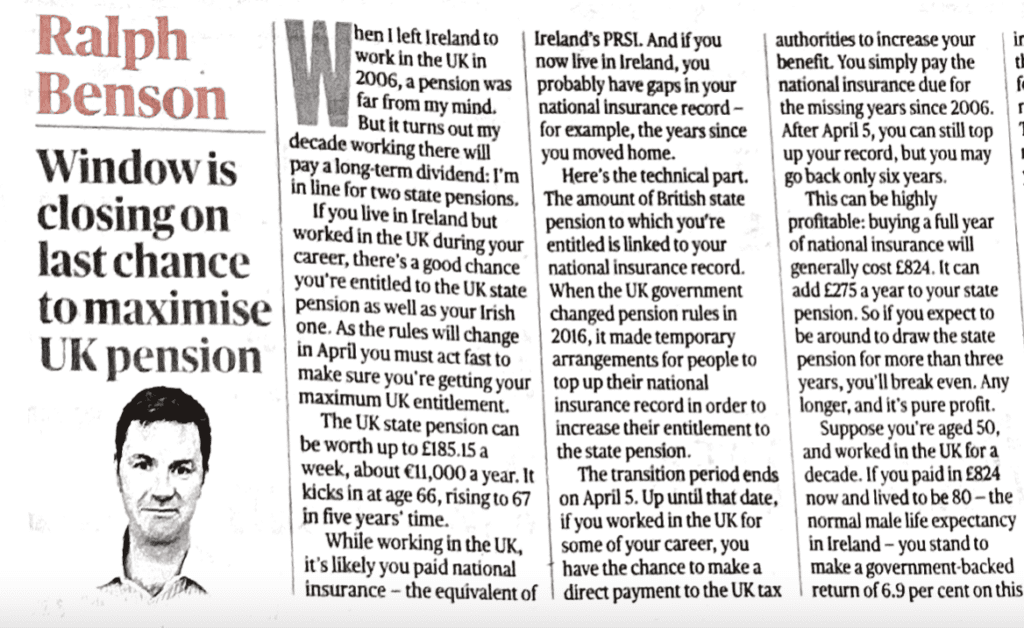If you live in Ireland but worked in the UK during your career, there’s a good chance you’re entitled to the UK state pension as well as your Irish one. As the rules will change soon, you must act fast to make sure you’re getting your maximum UK entitlement.
*** Update 8 March: The UK government has extended the deadline to 31 July 2023 ***
Moneycube can’t advise on the UK state pension but we’ve set out the key steps you can take to understand how your could benefit, based on our recent Sunday Times article.
The UK state pension can be worth up to £185.15 a week, about €11,000 a year. It kicks in at age 66, rising to 67 in five years’ time.
While working in the UK, it’s likely you paid national insurance — the equivalent of Ireland’s PRSI. And if you now live in Ireland, you probably have gaps in your national insurance record — for example, the years since you moved home.

Here’s the technical part. The amount of British state pension to which you’re entitled is linked to your national insurance record. When the UK government changed pension rules in 2016, it made temporary arrangements for people to top up their national insurance record in order to increase their entitlement to the state pension.
The transition period ends on 31 July 2023. Up until that date, if you worked in the UK for some of your career, you have the chance to make a direct payment to the UK tax authorities to increase your benefit. You simply pay the national insurance due for the missing years since 2006. After 31 July, you can still top up your record, but you may go back only six years.
This can be highly profitable: buying a full year of national insurance will generally cost £824. It can add £275 a year to your state pension. So if you expect to be around to draw the state pension for more than three years, you’ll break even. Any longer, and it’s pure profit.
Suppose you’re aged 50, and worked in the UK for a decade. If you paid in £824 now and lived to be 80 — the normal male life expectancy in Ireland — you stand to make a government-backed return of 6.9 per cent on this investment. If you live to 84 — the average life expectancy for women in Ireland — the return rises to 7.6 per cent. To put it another way, you’ll receive £6 back for every £1 you put in. (In fact could cost even less if you’re able to pay class 2 national insurance contributions; the UK authorities can advise you here).
Of course, the UK state pension, like its Irish equivalent, could change. Yet it’s as close to a guaranteed source of income as you’ll likely find these days.
Maximising your entitlement to the state pension makes sense in more than pure numbers terms. It also increases your financial resilience. For example, knowing that you have some solid pension provision through both the Irish and UK state pensions, you might decide to take additional risk with your work pension in search of higher investment gains.
Alternatively, you could decide to postpone drawing down your private pension in the knowledge that your state pensions will keep you afloat for longer.
It might even be the spur you need to dust down your overall pension portfolio. For example, you could track down your private UK pensions and perhaps bring them back to Ireland to create a unified, euro-based investment approach.
Where to start? The first step is to check your current entitlement to the UK state pension. Here’s the online calculator you’ll need.
If the calculator indicates you are presently entitled to less than £185.15 a week, then you have an opportunity to add to it.
Before you start sending money, there are some ways to increase your national insurance record for free, such as periods on statutory maternity pay or sick pay.
Beyond that, it’s time to run the numbers. If you’re intending to return to the UK to work, then you’ll likely make future national insurance contributions anyway. That might be enough to secure full pension rights. If you’re staying put in Ireland, you’ll need to pay in directly to increase your entitlement.
As ever with pensions, there are some exceptions. For certain public sector workers and self-employed people, different rules and rates will apply. The UK government runs a free helpline called the Future Pension Centre which can help you to understand your options.
Whatever your situation, it’s a good bet to call the Future Pension Centre before taking a decision here. Guess what: its advisers are going to be getting a lot of calls over the coming weeks. Don’t wait until the April 5 deadline is bearing down on you. Start tracking down your UK pension entitlements as soon as possible.
This piece is adapted from a Moneycube article which appeared in the Sunday Times on 29 January 2023.











You must be logged in to post a comment.